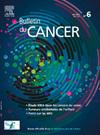Vestibulopathies et cancers de l’adulte : revue de la littérature
IF 0.8
4区 医学
Q4 ONCOLOGY
引用次数: 0
Abstract
Contexte
Les thérapeutiques utilisées au cours du cancer peuvent être responsables d’ototoxicité vestibulaire, d’autant plus difficile à détecter que nausées et vomissements sont fréquents chez des patients soumis à une fatigue et un stress important. Un diagnostic approprié permet de corriger au mieux les symptômes, de limiter le risque de chute et d’améliorer la qualité de vie.
Matériel et méthodes
Après un rappel synthétique sur l’anatomie, la physiologie et les principes de l’exploration du vestibule, une revue narrative des principales vestibulopathies rencontrées chez les patients traités pour un cancer est effectuée, en détaillant leur exploration puis les traitements anticancéreux responsables d’ototoxicité vestibulaire.
Principales données retenues
L’ototoxicité vestibulaire des traitements systémiques se présente le plus souvent comme une vestibulopathie bilatérale chronique. Les explorations fonctionnelles vestibulaires permettent de différencier les atteintes centrales et périphériques, de quantifier les atteintes et d’orienter vers un bilan d’imagerie. Les sels de platines sont les principaux agents pourvoyeurs d’ototoxicité cochléaire, leurs mécanismes de toxicité sur le vestibule restent flous. Des cas d’ototoxicité vestibulaire sont décrits dans les immunothérapies par inhibiteurs de checkpoint. La radiothérapie et les invasions tumorales directes peuvent aussi provoquer des atteintes vestibulaires. L’ensemble des altérations vestibulaires est pourvoyeur de chute, notamment chez la personne âgée. Un bilan vestibulaire par un oto-rhino-laryngologiste est indiqué ; le traitement repose habituellement sur la rééducation vestibulaire.
Conclusion
Un circuit entre oncologue et oto-rhino-laryngologiste est capital pour l’exploration de la fonction vestibulaire lors des traitements de cancer avec un potentiel ototoxique.
Context
Therapeutics used in cancer treatment can cause vestibular ototoxicity, which is particularly challenging to detect due to the frequent occurrence of nausea and vomiting in patients experiencing significant fatigue and stress. An appropriate diagnosis enables optimal symptom correction, reduces the risk of falls, and improves quality of life.
Materials and methods
Following a concise overview of the anatomy, physiology, and principles of vestibular exploration, a narrative review of the primary vestibulopathies encountered in cancer patients is conducted. This review details their exploration and the anti-cancer treatments responsible for vestibular ototoxicity.
Key findings
Vestibular ototoxicity from systemic treatments typically presents as chronic bilateral vestibulopathy. Vestibular functional tests differentiate between central and peripheral lesions, quantify the damage, and guide imaging assessments. Platinum salts are the main agents causing cochlear ototoxicity, although their toxicity mechanisms on the vestibular system remain unclear. Cases of vestibular ototoxicity have been described with immune checkpoint inhibitors. Radiotherapy and direct tumor invasion can also cause vestibular damage. All vestibular alterations increase the risk of falls, particularly in the elderly. A vestibular assessment by an otolaryngologist is indicated; treatment usually involves vestibular rehabilitation.
Conclusion
Collaboration between oncologists and otolaryngologists is crucial for evaluating vestibular function during cancer treatments with potential ototoxicity.
[前庭病变与成人癌症:文献综述]。
背景:用于癌症治疗的药物可引起前庭耳毒性,由于在经历严重疲劳和压力的患者中经常发生恶心和呕吐,因此前庭耳毒性尤其难以检测。适当的诊断可以最佳地纠正症状,减少跌倒的风险,并提高生活质量。材料和方法:在简要概述前庭探查的解剖学、生理学和原理之后,对癌症患者遇到的原发性前庭病变进行叙述回顾。现就前庭耳毒性的研究进展及抗癌治疗作一综述。主要发现:系统治疗引起的前庭耳毒性通常表现为慢性双侧前庭病变。前庭功能检查可区分中枢性和外周性病变,量化损伤,并指导影像学评估。铂盐是引起耳蜗耳毒性的主要物质,但其对前庭系统的毒性机制尚不清楚。前庭耳毒性病例已被描述为使用免疫检查点抑制剂。放射治疗和肿瘤直接侵袭也可引起前庭损伤。所有前庭病变都会增加跌倒的风险,尤其是老年人。由耳鼻喉科医生进行前庭评估;治疗通常包括前庭康复。结论:肿瘤科医生和耳鼻喉科医生的合作对于评估具有潜在耳毒性的癌症治疗过程中的前庭功能至关重要。
本文章由计算机程序翻译,如有差异,请以英文原文为准。
求助全文
约1分钟内获得全文
求助全文
来源期刊

Bulletin Du Cancer
医学-肿瘤学
CiteScore
1.90
自引率
16.70%
发文量
224
审稿时长
37 days
期刊介绍:
Without doubt, the ''Bulletin du Cancer'' is the French language publication of reference in the field of cancerology. Official organ of the French Society of Cancer, this journal covers all the information available, whether in the form of original articles or review articles, but also clinical cases and letters to the editor, including various disciplines as onco-hematology, solids tumors, medical oncology, pharmacology, epidemiology, biology as well as fundamental research in cancerology. The journal proposes a clinical and therapeutic approach of high scientific standard and regular updates in knowledge are thus made possible. Articles can be submitted in French or English.
 求助内容:
求助内容: 应助结果提醒方式:
应助结果提醒方式:


